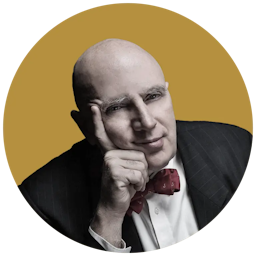A Composer and Conductor All at Once
This article is from the archive of The New York Sun before the launch of its new website in 2022. The Sun has neither altered nor updated such articles but will seek to correct any errors, mis-categorizations or other problems introduced during transfer.

I first had an inkling of the sense of humor of jazz musician Lawrence “Butch” Morris some 20 years ago, when we were both working as sales clerks at Tower Records. A customer wanted to know about a certain album, and Mr. Morris told him, “You’ll enjoy it if you’re a real avant-garder.” Despite his day job, Mr. Morris was even then well-respected in the jazz avant-garde, so it seemed like a good opportunity to get him to define that music. “What do you mean by avant-garder?” I inquired, asking for trouble. Dodging a bullet, Mr. Morris pointed to his leg and said “here!” as if to indicate a sock garter.
Jokes aside, Butch Morris has spent the last three decades helping to define and redefine the meaning of the jazz avant-garde. When I first heard him play, in the late 1970s, he had already established a place for himself in the downtown scene as a promising instrumentalist (he plays cornet) and composer. But in the last two decades, he has developed music and performance techniques that transcend the boundaries of jazz and have created a new role in American vernacular music – that of the conductor.
In symphonic music, the conductor is king. In jazz, the act of leading a band traditionally hasn’t meant much more than giving a downbeat and occasionally sharpening accents and dynamics. Duke Ellington did his band-leading in advance, when he wrote down most of what he wanted his ensemble to play; at the actual performance, he, like Count Basie, did most of his conducting from the piano.
Mr. Morris, who will inaugurate a new big-band series at Sweet Rhythm on Thursday with the Vision Festival Orchestra assembled by tenor saxophonist J.D. Allen, not only conducts jazz ensembles, he spontaneously creates the music with a technique he calls “conduction.”
The basic pitches of Mr. Morris’s works are notated, and an elaborate vocabulary of signs and gestures indicates everything else to the player. There are more than 100 of these symbols, but when Mr. Morris works with a new group of players, he considers himself lucky to teach them a basic 15 or so. His conduction shapes what the musicians play, both as an ensemble and as soloists, and he can shape the form of the work by indicating when a passage should be repeated.
“My goal is to re-energize the music with an extra dimension, what I call the elements of spontaneity, momentum, combustion, ignition, and propulsion,” he told me in an interview. “Most conductors interpret scores from a printed page. I make music.”
Mr. Morris came of age in the Los Angeles avant-garde scene of the late 1960s and early 1970s, collaborating with, among others, tenor saxophonist David Murray and bassist Charles Moffett. He moved to New York in 1981 and attracted the attention of the jazz world at large through his extended collaboration with Mr. Murray in the 1980s and 1990s.Their most celebrated release, a 1991 CD simply titled “The David Murray Big Band Conducted by Lawrence ‘Butch’ Morris,” was distributed in the United States by Sony – very rare for an avant-garde album.
Mr. Morris began performing his conduction opuses 20 years ago. He credits Moffett as the main inspiration for the concept of conduction: “Everyone else told me what I couldn’t do; Charles was the only one who told me what I could.” He gradually worked out the process, and discovered that others, such as Leonard Bernstein, Lukas Foss, and Frank Zappa, had done things that were similar. He also read about an ancient technique called chironomy that was employed as far back as 1500 B.C.
“I kept looking for a way to enhance the dialogue between musicians and composers,” he said. “I noted that improvisation was fairly prominent 200 years ago, that Bach left empty bars in his ‘St. Matthew’s Passion’ for players to ad-lib in, but sometime in the 19th century they were filled in.”
Both with and without Mr. Murray, Mr. Morris’s music covers the entire gamut of jazz music, from lush, Ellingtonian sonorities to screaming “outside” sounds seemingly bereft of any sense of rhythm, melody, or form. He has performed conductions with Turkish folk musicians, Japanese traditionalists, and symphonic ensembles. He’s worked with what he describes as a “chorus of poets,” and conducted an opera in which mannequins featured prominently. His performances with string ensembles have suggested the work of Schonberg and Stravinsky.
Over the last 20 years, he has performed with more than 5,000 musicians in 22 countries and 60 cities, in ensembles ranging from a mere dozen musicians or less to a gigantic orchestra of 150. Earlier this year he presided over “Black February,” in which he spent the entire month conducting different ensembles in different parts of the city. Last month Mr. Morris conducted string orchestras at Barbes in Park Slope and the Stone on Avenue C. Because each performance is so different from the others, at one point he began numbering them. The result looks something like the opus numbers used to catalog the works of classical composers.
Mr. Morris’s continued presence in New York is one of the major blessings of the metropolitan jazz scene. After all these years, Mr. Morris doesn’t like hearing conduction referred to as an “experimental” technique. “The more you think about it,” Mr. Morris said, “the more you realize, ‘Hey, it’s not so far-fetched!'”
Mr. Morris performs with J.D. Allen and the Vision Festival Orchestra at Sweet Rhythm (88 Seventh Avenue South, between Grove and Bleecker Streets, 212-255-3626). $15 + $10 minimum.

